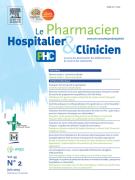Évaluation à un an de l’information reçue par les patients ambulatoires sur l’interaction rilpivirine–modificateurs du pH gastrique - 23/09/16
 : interne en pharmacie hospitalière, B. Coat : interne en pharmacie hospitalière, L. Kramer : pharmacien, assistant spécialiste des hôpitaux, N. Abbas : pharmacien, attaché des hôpitaux, C. Guerin : pharmacien, praticien hospitalier, F. Chast : chef de service de pharmacie, praticien hospitalier, professeur des universités
: interne en pharmacie hospitalière, B. Coat : interne en pharmacie hospitalière, L. Kramer : pharmacien, assistant spécialiste des hôpitaux, N. Abbas : pharmacien, attaché des hôpitaux, C. Guerin : pharmacien, praticien hospitalier, F. Chast : chef de service de pharmacie, praticien hospitalier, professeur des universités| pages | 9 |
| Iconographies | 3 |
| Vidéos | 0 |
| Autres | 0 |
Résumé |
Introduction |
Afin d’éviter un sous-dosage de la rilpivirine, la prise concomitante avec un repas et la mise en garde de l’interaction avec les anti-acides et anti-sécrétoires doivent être recommandées au patient. Deux audits ont été réalisés à un an d’intervalle afin d’évaluer les connaissances des patients s’y rapportant et les pratiques pharmaceutiques de notre rétrocession hospitalière.
Matériel et méthodes |
Une méthode d’évaluation prospective des pratiques professionnelles, par audit clinique, a été retenue. La grille d’évaluation consistait en un questionnaire proposé aux patients. Un document d’information spécifique leur a été remis. Un nouveau questionnaire a été proposé un an plus tard, évaluant l’impact de la dispensation du dépliant.
Résultats |
Il n’y a pas eu d’amélioration significative de la connaissance de la prise de rilpivirine avec la nourriture (92 % versus 89 %) ni de l’interaction avec les modificateurs du pH gastrique (50 % versus 54 %). Le dépliant d’information n’a pas été conservé par tous les patients et seuls 33 % déclarent l’avoir reçu.
Discussion/Conclusion |
Le dépliant d’information remis à chaque première dispensation de rilpivirine est insuffisant ; il est désormais proposé plus régulièrement. L’information renforcée par un entretien pharmaceutique orienté reste essentielle.
Le texte complet de cet article est disponible en PDF.Summary |
Introduction |
To avoid rilpivirine's under-dosing, intake during a meal and warning about drug-interaction with antacids and antisecretories must be recommended to patients. Two audits were conducted a year apart to assess patient knowledge about these advices, and thus to evaluate the pharmaceutical and medical practices in our hospital pharmacy.
Materials and methods |
A prospective method for assessing professional practices, a clinical audit, was retained. The evaluation grid to patients was a questionnaire. An information leaflet on intaking and interactions was given to them. A new questionnaire was proposed a year later, assessing the impact of the leaflet dispensation.
Results |
There was no significant improvement in the knowledge of intaking rilpivirine with food (92% versus 89%) and the interaction with the gastric pH modifiers (50% versus 54%). The information document has not been kept by all patients and only 33% of patients who responded to both questionnaires reported having received it.
Discussion/Conclusion |
Information leaflet given to each new rilpivirine's dispensation is insufficient given to each first dispensation of rilpivirine is insufficient; it is now proposed more regularly. The information reinforced by an oriented pharmaceutical meeting remains essential.
Le texte complet de cet article est disponible en PDF.Mots clés : Anti-acide, Anti-sécrétoire, Évaluation, Interaction médicamenteuse, Nourriture, Rilpivirine, PH gastrique, VIH
Keywords : Antacid, Antisecretory, Evaluation, Drug interaction, Food, Gastric pH, HIV, Rilpivirine
Plan
Vol 51 - N° 3
P. 232-240 - septembre 2016 Retour au numéroBienvenue sur EM-consulte, la référence des professionnels de santé.
L’accès au texte intégral de cet article nécessite un abonnement.
Bienvenue sur EM-consulte, la référence des professionnels de santé.
L’achat d’article à l’unité est indisponible à l’heure actuelle.
Déjà abonné à cette revue ?

